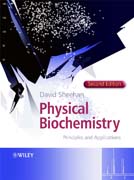
Now in a new, thoroughly updated edition, Physical Biochemistry provides a broad overview of the key techniques currently used to characterize the structure and function of complex biomacromolecules such as proteins and DNA. INDICE: Preface. Chapter 1 Introduction. 1.1 Special Chemical Requirementsof Biomolecules. 1.2 Factors Affecting Analyte Structure and Stability. 1.3 Buffering Systems Used in Biochemistry. 1.4 Quantitation, Units and Data Handling. 1.5 The Worldwide Web as a Resource in Physical Biochemistry. 1.6 Objectives of this Volume. References. Chapter 2 Chromatography. 2.1 Principles of Chromatography. 2.2 Performance Parameters Used in Chromatography. 2.3 Chromatography Equipment. 2.4 Modes of Chromatography. 2.5 Open Column Chromatography. 2.6 High Performance Liquid Chromatography (HPLC). 2.7 Fast Protein Liquid Chromatography. 2.8 Perfusion Chromatography. 2.9 Membrane-Based Chromatography Systems. 2.10 Chromatography of a Sample Protein. References. Chapter 3 Spectroscopic Techniques. 3.1 The Nature of Light. 3.2 The Electromagnetic Spectrum. 3.3 Ultraviolet/Visible Absorption Spectroscopy. 3.4 Fluorescence Spectroscopy.3.5 Spectroscopic Techniques Using Plane-Polarized Light. 3.6 Infrared Spectroscopy. 3.7 Nuclear Magnetic Resonance (NMR) Spectroscopy. 3.8 Electron Spin Resonance (ESR) Spectroscopy. 3.9 Lasers. 3.10 Surface Plasmon Resonance. References. Chapter 4 Mass Spectrometry. 4.1 Principles of Mass Spectrometry. 4.2 Mass Spectrometry of Proteins/Peptides. 4.3 Interfacing MS with other Methods. 4.4 Uses of Mass Spectrometry in Biochemistry. References. Chapter 5 Electrophoresis. 5.1 Principles of Electrophoresis. 5.2 Nondenaturing Electrophoresis. 5.3 Denaturing Electrophoresis. 5.4 Electrophoresis in DNA Sequencing. 5.5 Isoelectric Focusing (IEF). 5.6 Immunoelectrophoresis. 5.7 Agarose Gel Electrophoresis of Nucleic Acids. 5.8 Pulsed Field Gel Electrophoresis. 5.9 Capillary Electrophoresis. 5.10 Electroblotting Procedures. 5.11 Electroporation. References. Chapter 6 Three-Dimensional Structure Determination of Macromolecules. 6.1The Protein-Folding Problem. 6.2 Structure Determination by NMR. 6.3 Crystallization of Biomacromolecules. 6.4 X-Ray Diffraction by Crystals. 6.5 Calculation of Electron Density Maps. 6.6 Other Diffraction Methods. 6.7 Comparison of X-Ray Crystallography with Multi-Dimensional NMR. 6.8 Structural Databases. References. Chapter 7 Hydrodynamic Methods. 7.1 Viscosity. 7.2 Sedimentation. 7.3 Methods for Varying Buffer Conditions. 7.4 Flow Cytometry. References. Chapter 8 Biocalorimetry. 8.1 The Main Thermodynamic Parameters. 8.2 Isothermal Titration Calorimetry. 8.3 Differential Scanning Calorimetry. 8.4 Determination of Thermodynamic Parameters by Non-Calorimetric Means. References. Chapter 9 Bioinformatics. 9.1 Overview of Bioinformatics. 9.2 Sequence Databases. 9.3 Tools for Analysis of Primary Structures. 9.4 Tertiary Structure Databases. 9.5 Programs for Analysis and Visualization of Tertiary Structure Databases. 9.6 Homology Modelling. References. Chapter 10 Proteomics. 10.1 Electrophoresis in Proteomics. 10.2 Mass Spectrometry in Proteomics. 10.3 Chip Technologies in Proteomics. 10.4 Post-Translational Modification Proteomics. Further Reading. References. Appendix 1 SI Units. Appendix 2 The Fourier Transform. Index.
- ISBN: 978-0-470-85603-1
- Editorial: John Wiley & Sons
- Encuadernacion: Rústica
- Páginas: 424
- Fecha Publicación: 27/03/2009
- Nº Volúmenes: 1
- Idioma: Inglés
